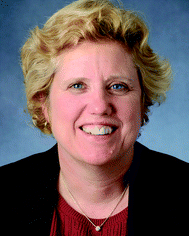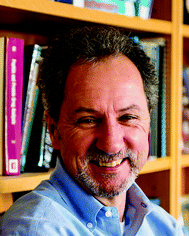In celebration of the 60th birthday of 2 microfluidics pioneers: Professor Susan Lunte and Professor James Landers
Christopher J.
Easley
a,
Fiona
Regan
b,
Michael G.
Roper
c and
R. Scott
Martin
*d
aAuburn University, 179 Chemistry Building, Auburn, AL 36849, USA
bDublin City University, Glasnevin, Dublin 9, Ireland
cFlorida State University, 95 Chieftain Way, Tallahassee, Fl 32306, USA
dSaint Louis University, 1 N. Grand Blvd., St. Louis, MO 63103, USA. E-mail: scott.martin@slu.edu
Susan Lunte (Sue to those that know her well) is currently the Ralph N. Adams Distinguished Professor of Chemistry and Pharmaceutical Chemistry and Director of the Adams Institute for Bioanalytical Chemistry at the University of Kansas. She is also the former Editor-in-Chief of Analytical Methods. Sue and her group have focused on the development and application of capillary and microfluidic systems that enable quantitation of important markers in biological systems. She has published over 150 papers and 15 book chapters in this area. Early in her career, her research focused on capillary electrophoresis, with many papers detailing new electrochemical detection schemes for this then new separation method.1–3 Her group quickly realized that the small sample volume requirements of CE could be used to make high temporal resolution measurements from microdialysis sampling, with several key papers of continuously monitoring in vivo systems with microdialysis and CE.4,5 Around the year 2000, her group started to explore the use of microchip-based analysis systems, with several demonstrations of electrochemical detection for microchip electrophoresis.6,7 This was followed by key papers describing the integration of microdialysis sampling with microchip-based analysis,8,9 including a “Lab-on-a-Sheep” system.10 More recent work includes using microfluidics to investigate the production of reactive oxygen species in cellular systems.11,12 These achievements have been recognized with several awards including an AAPS Research Achievement Award, the Purdue University Chemistry Department Outstanding Alumnus Award and, most recently, the ANACHEM Award, which will be awarded at SciX 2018.
While this is not an exhaustive overview of her body of work, it is clear that she has made a large impact on the fields of bioanalytical chemistry and biomedical analysis. Because of this impact, it is quite fitting to recognize her and her pivotal work in this special issue of Microfluidic Systems with Societal Impact. All four authors of this editorial can also attest to what a great mentor Sue has been to junior scientists over the years. This includes undergraduate and graduate students, post-docs (Scott Martin being one of many she mentored), visiting scientists from Brazil and Ireland (Fiona Regan being one example), and junior faculty members (such as Chris Easley and Mike Roper). We all have benefited from her advice, promotion, thoughtfulness and friendship over the years.
James P. Landers is the Commonwealth Professor in the Departments of Chemistry, Mechanical Engineering, and Pathology at the University of Virginia (UVA). He is also the Director of the Center for Nano-Biosystems Integration, a member of the UVA Cancer Center, a Jefferson Scholar Faculty Fellow, and serves as an Editor for Analytica Chimica Acta. For his pioneering and continuing work toward scientific advancements, education, and training in the area of microfluidic devices with high societal impact, this editorial also honors Professor Landers on the occasion of his 60th birthday.
James began his unique research style as he launched and directed the Mayo Clinic’s Clinical Capillary Electrophoresis (CE) Facility in the Department of Laboratory Medicine and Pathology, developing clinical assays based on CE technology. Afterwards, he began his independent faculty career at the University of Pittsburgh before moving to UVA in 1999. Throughout his career, he has been an innovator in the field of microfluidic system development. Notable early achievements include his pioneering work in rapid, on-chip DNA amplification,13 on-chip separations for clinical applications,14 and on-chip solid-phase extraction of DNA from body fluids.15 Using this groundwork, his group (incl. Easley and Roper) was one of the first to demonstrate a fully-integrated lab-on-a-chip system capable of DNA extraction, amplification, and separation directly from blood or nasal aspirates.16 He has translated this and similar systems to the forensic community for rapid analysis of fluids and tissues present at crime scenes.17,18 Lately, his group has developed unique fluidic control strategies,19,20 a novel “pinwheel” approach for simplified nucleic acid detection,21 centrifugal microfluidics,22 and inexpensive device fabrication methodology.22,23 James has authored more than 250 papers and has edited three editions of the CRC Press Handbook of Capillary Electrophoresis,24 with the latest edition including microchip electrophoresis and associated microtechniques. He has mentored numerous undergraduate researchers, PhD students (such as Chris Easley), and postdocs (such as Mike Roper); and many have gone on to have successful careers in the sciences. Those who have worked closely with him will attest that James has a unique ability to see the big picture, particularly in the areas of clinical diagnostics and forensic analysis, and how research can benefit these fields. As members of his laboratory push forward with sample preparation, separations, and analysis at the microscale, they have the rare advantage of an open view to their end application due to James’s mentoring.
On a personal note, James has always been a supportive mentor who welcomes everyone in his laboratory by hosting BBQs on his back porch, playing hockey games with them in the basement of his home, and regaling them with stories of growing up in Canada. He is warm-hearted and will always do whatever he can to help out his students and members of his lab, current and former.
We wish both Sue and James Happy Birthday and look forward to their scientific contributions for many years to come. We wish them continued success in the lab and in life!
Sue Lunte
James Landers
References
- M. Zhong, J. Zhou, S. M. Lunte, G. Zhou, D. M. Giolando and J. Kirchhoff, Anal. Chem., 1996, 68, 203–207 CrossRef PubMed.
- T. J. O’Shea and S. M. Lunte, Anal. Chem., 1993, 65, 247–250 CrossRef.
- L. A. Holland and S. M. Lunte, Anal. Chem., 1999, 71, 407–412 CrossRef PubMed.
- S. Y. Zhou, H. Zuo, J. F. Stobaugh, C. E. Lunte and S. M. Lunte, Anal. Chem., 1995, 67, 594–599 CrossRef PubMed.
- J. Zhou, D. M. Heckert, H. Zuo, C. E. Lunte and S. M. Lunte, Anal. Chim. Acta, 1999, 379, 307–317 CrossRef.
- R. S. Martin, A. J. Gawron and S. M. Lunte, Anal. Chem., 2000, 72, 3196–3202 CrossRef PubMed.
- R. S. Martin, A. J. Gawron, B. A. Fogarty, F. B. Regan, E. Dempsey and S. M. Lunte, Analyst, 2001, 127, 277–280 RSC.
- B. Huynh, B. A. Fogarty, R. S. Martin and S. M. Lunte, Anal. Chem., 2004, 76, 6440–6447 CrossRef PubMed.
- P. Nandi, D. E. Scott, D. Desai and S. M. Lune, Electrophoresis, 2013, 34, 895–902 CrossRef PubMed.
- D. E. Scott, S. D. Willis, S. Gabbert, D. Johnson, E. Naylor, E. M. Janle, J. E. Krichevsky, C. E. Lunte and S. M. Lunte, Analyst, 2015, 140, 3820–3829 RSC.
- E. C. Metto, K. Evans, P. Barney, A. H. Culbertson, D. B. Gunasekara, G. Caruso, M. K. Hulvey, J. A. Fracassi da Silva, S. M. Lunte and C. T. Culbertson, Anal. Chem., 2013, 85, 10188–10195 CrossRef PubMed.
- G. Caruso, C. G. Fresta, J. M. Siegel, M. B. Wijesinghe and S. M. Lunte, Anal. Bioanal. Chem., 2017, 409, 4529–4538 CrossRef PubMed.
- R. P. Oda, M. A. Strausbauch, S. R. Jurrens, J. Craighead, P. J. Wettstein, B. Eckloff, B. Kline and J. P. Landers, Anal. Chem., 1998, 70(20), 4361–4368 CrossRef PubMed.
- R. P. Oda, R. Clark, J. A. Katzmann and J. P. Landers, Electrophoresis, 1997, 18(10), 1715–1723 CrossRef PubMed.
- M. C. Breadmore, K. A. Wolfe, I. G. Arcibal, W. K. Leung, D. Dickson, B. C. Giordano, M. E. Power, J. P. Ferrance, S. H. Feldman, P. M. Norris and J. P. Landers, Anal. Chem., 2003, 75(8), 1880–1886 CrossRef PubMed.
- C. J. Easley, J. M. Karlinsey, J. M. Bienvenue, L. A. Legendre, M. G. Roper, S. H. Feldman, M. A. Hughes, E. L. Hewlett, T. J. Merkel, J. P. Ferrance and J. P. Landers, Proc. Natl. Acad. Sci. U. S. A., 2006, 103(51), 19272–19277 CrossRef PubMed.
- K. M. Horsman, S. L. Barker, J. P. Ferrance, K. A. Forrest, K. A. Koen and J. P. Landers, Anal. Chem., 2005, 77(3), 742–749 CrossRef PubMed.
- J. M. Bienvenue, L. A. Legendre, J. P. Ferrance and J. P. Landers, Forensic Sci. Int.: Genet., 2010, 4(3), 178–186 CrossRef PubMed.
- D. C. Leslie, C. J. Easley, E. Seker, J. M. Karlinsey, M. Utz, M. R. Begley and J. P. Landers, Nat. Phys., 2009, 5(3), 231–235 Search PubMed.
- K. Xu, M. R. Begley and J. P. Landers, Lab Chip, 2015, 15(3), 867–876 RSC.
- J. Li, Q. Liu, H. Alsamarri, J. A. Lounsbury, D. M. Haversitick and J. P. Landers, Lab Chip, 2013, 13(5), 955–961 RSC.
- Y. Ouyang, J. Li, C. Phaneuf, P. S. Riehl, C. Forest, M. Begley, D. M. Haverstick and J. P. Landers, Lab Chip, 2016, 16(2), 377–387 RSC.
- B. L. Thompson, R. J. Gilbert, M. Mejia, N. Shukla, D. M. Haverstick, G. T. Garner and J. P. Landers, Anal. Chim. Acta, 2016, 924, 1–8 CrossRef PubMed.
- Handbook of Capillary and Microchip Electrophoresis and Associated Microtechniques, ed. J. P. Landers, CRC Press, Boca Raton, FL, USA, 3rd edn, 2007 Search PubMed.
| This journal is © The Royal Society of Chemistry 2018 |


